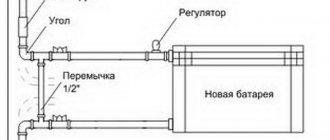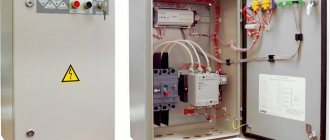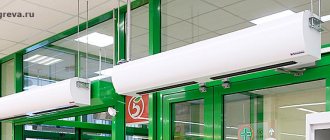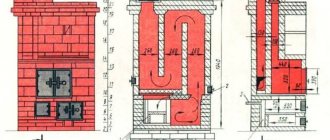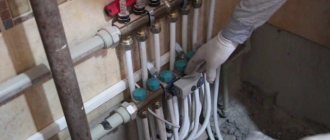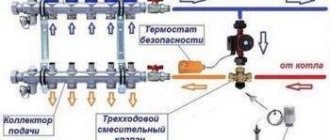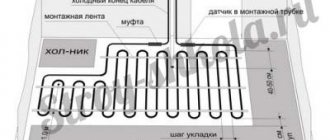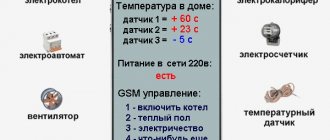When installing a room heating system with heated floors, the question arises of how to control a water heated floor and an electric one, and which thermostat is best to purchase.
There are mechanical and automatic indoor climate control systems on sale.
Let's look at the advantages and disadvantages of various types of thermostats, what a controller is for a heated floor, and control circuits for a room heating system.
Comparison of automation and mechanics
Heated floor control is carried out using thermostats, which are produced in the form of mechanical and automatic devices; let’s look at their comparative characteristics in the table:
| Options | Mechanics | Automation |
| Price | 3-4 thousand rubles. | 10-20 thousand rubles. |
| Adjustment of work | manually | automatically |
| Control | manual | automatic |
| Screen | No | There is |
| Temperature meter | No, you will have to adjust the temperature based on your own tactile sensations. | Yes, the sensor regulates the maintenance of the required parameters. |
Mechanical systems are equipped with thermostats
In a mechanical device, thermostats are installed on the supply pipe of each loop of the heating system, with the help of which the volume of hot water supply is manually reduced or increased.
Electronic temperature sensors regulate the supply of hot water by installing a “small motor (servo)” system on each loop, which forces the water supply into the loop. The thermostat, which measures the temperature in the room, sends commands to the servo drive and is mounted in the same room where the heating loop is located.
Depending on the temperature readings, the thermostat commands the servo drive to increase or decrease the hot water supply speed.
The most in demand are automatic systems for monitoring water pipelines for the floor; they are capable of maintaining a given temperature level, in an economical mode they can be turned on a certain time before the owners arrive from work; even older people and children can control the automation.
TECH Controllers systems for controlling water heated floors
In short, Tech controllers for heated floors are automatic devices that regulate the supply of coolant depending on the readings of temperature sensors and the temperature parameters set by the owner.
Automation for underfloor heating Tech Controllers, depending on the specific model, can control and adjust the operation of thermostatic heads and valves, servos, mixing valves, circulation pump and heating boiler. Some systems have additional functions, for example, weather-dependent control, the ability to remotely control and control a heated floor from a GSM smartphone or via the Internet, which is especially important if their owner only visits the house on short visits. You can buy TECH Controllers for heating here...
Using Tech L floor heating control systems allows you to:
- ensure thermal comfort in rooms, thanks to the control of up to 8 different zones with different temperature conditions
- ensure thermal energy savings thanks to precise temperature control in different heating zones
- reduce installation costs thanks to wireless connection with room sensors or thermostats (Tech L-8, Tech L-6)
- possibility of using budget systems with a wired connection (Tech L-5 and L-7).
- It is possible to remotely control the heating system via the Internet. The manufacturer offers: • cloud service services emodul.eu • applications for mobile devices based on Android and IOS • wireless portable touch control panel Tech M-8
The range of systems for controlling water heated floors based on various controllers from Tech Controllers of the L-8, L-7, L-6 and L-5 series is distinguished by its functionality for controlling the heating system: L-8 is the top, most functional version and up to up to L-5 - the most budget option. Controllers, depending on the series, can only be used with certain additional devices that are suitable for operation only with this model of mounting plate.
Comparison of functionality of water heated floor control systems TECH L-8, L-7, L-6 and L-5
The capabilities of Tech controllers largely depend on additional components that are used to expand functionality depending on the specific needs of the consumer. Below is a table of compatibility of Tech add-on devices with various main L-series controllers.
Functionality of the wireless system for controlling water heated floors Tech L-8:
servicing a maximum of 22 thermostatic servos using 8 room sensors Tech C-8R or room thermostats Tech R-8B, R-8Z, R-8K: - 3 room sensors make it possible to service up to 12 servos (each with a maximum of 4 servos) - 5 room sensors can be served by up to 10 servos (each with a maximum of 2 servos) there is one 230 V output for the pump there is a potential-free (dry) contact, for example, to control a heating boiler You can additionally connect to the controller: - wireless control panel Tech M-8 with RS communication — Tech ST-507 Internet or Tech WiFi RS to control the controller via the Internet — Tech ST-61v4 or ST-431n valve module software can be updated via USB port control of Tech STT-868 wireless thermostatic servos (6 pieces per section)
Equipment for the TECH L-8 system
Automation functions
An automatic thermostat is capable of performing many functions in adjusting the intensity of heating a room using a water floor:
- Determines the heating temperature of water in the pipeline, turns on or off the circulation pump. This type of control of water flow in a pipeline is suitable for apartments and houses in which several pumps are installed. If there is one pump for the whole house, then the system will turn the heating on or off (depending on the water temperature) in all rooms at once.
- Semi-automatic control of the thermal head is quite simple and inexpensive. Allows you to regulate the intensity of water supply: the valve closes or opens depending on the degree of heating.
- Control is carried out by installing a servo drive on the collector; with its help, the heat supply to individual rooms is simultaneously regulated.
- A modern automatic thermostat can save up to 1/3 of gas consumption or 1/7 of wood for heating a room. Can adjust the degree of heating depending on the weather outside. Such a controller for a heated floor has many sensors, some of which are mounted outdoors, the rest indoors. Based on their readings and the settings, the heating intensity of each room is adjusted individually.
The heating temperature sensor can be installed inside or outside. It is not recommended to install a thermostat in the bathroom, kitchen or other rooms with high humidity. About wireless automation in adjusting heated floors, watch this video:
If underfloor heating is used as the main system, it is better to purchase a thermostat that regulates the level of air heating in the room.
If you have laid a floor covering that is not resistant to high temperatures, then it is better to install a floor heating sensor.
For the main water heated floor system, it is better to install a device with the ability to connect two sensors.
Circulation pump control
This is the simplest type of control: depending on the temperature of the coolant, the pump will turn on/off.
To implement this method you do not need a lot of knowledge or special qualifications. And the “automation for heated floors” is not used here: it’s just a room thermostat and nothing more.
The circulation pump control diagram looks like this:
As you can see, there is a thermostat installed in any room; when the set temperature is reached, the thermostat operates and turns off or turns on the pump.
This is how you can easily control the floor temperature automatically:
Here the thermostat monitors the readings of a sensor mounted in the floor between (and not on one pipe!) the pipes. The sensor gives a command to the thermostat, which processes the received signal and turns the circulation pump on/off.
Disadvantage: if there is one common pump for the whole house, then this method is not always suitable, because the pump is turned off by a thermostat installed in one room, and when the pump is turned off, the heating will stop throughout the house. This method is suitable if there are two pumps, for example, on different floors, and you need to control the heating on one floor without touching the second.
Custom controllers
Heated floors are controlled by installing sensors that regulate the intensity of air heating in the room and are able to maintain the heating temperature at a given level.
Device operation diagram:
The owner sets certain parameters for the thermostat. When the temperature rises or falls, the device turns the water heating system on or off.
Group controllers
The controller for heated floors makes it possible to regulate the water supply to several collectors. Such devices can be used in rooms with high humidity levels.
The thermostat maintains a constant temperature of the water in the pipes
Water supply control is regulated due to the following points:
- mixing water units are grouped so that it is possible to regulate the rate of hot water flow in several units simultaneously;
- when installing a branching system of individual mixing units, the heated floor can be controlled in one unit;
- a certain temperature in all rooms is maintained thanks to a thermostat installed in a 2 or 3 way valve;
- climate control is carried out using a modern system that includes many sensors, thanks to which the specified microclimate parameters in the room are maintained. For more information about underfloor heating control systems, watch this video:
The group controller is directly connected to the servo drive. Thanks to the signal supplied by the device, the valve that regulates the water supply is activated.

